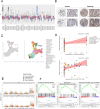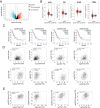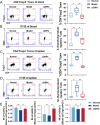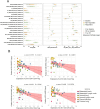Dendrobium huoshanense polysaccharide inhibits NSCLC proliferation and immune evasion via FXR1-IL-35 axis signaling pathway
- PMID: 40259042
- PMCID: PMC12228671
- DOI: 10.1007/s11418-025-01894-7
Dendrobium huoshanense polysaccharide inhibits NSCLC proliferation and immune evasion via FXR1-IL-35 axis signaling pathway
Abstract
Dendrobium huoshanense has received special attention for its advantages in the treatment of lung cancer, but the underlying molecular mechanisms are not yet well understood. First, we obtained 8 active ingredients and 159 effective action targets of Dendrobium huoshanense using network pharmacology, and searching target interactions through STRING, constructing the PPI network and KEGG, GO and Hallmark enrichment analysis. Then, we combined target's enrichment analysis and GSEA enrichment analysis of IL-35, indicating the mechanism of cDHPs for non-small cell lung cancer (NSCLC) may be related to tight junction and NSCLC pathway. Further, FXR1 and ACTR3 were identified as core therapeutic targets, and high expression of FXR1 or ACTR3 was significantly associated with poor prognosis of patients. The analysis of single-cell data also indicated that the percentage of CD4-CTLA4-Treg cells may be increased by the expression of IL-35, resulting in a suppressive immune microenvironment. Next, In vivo experiment, we detected iTr35 by flow cytometry, detected IL-35 level by RT-PCR, Western blotting and ELISA, and detected NK cell activity to explore the immunomodulatory effects and anti-tumor mechanism of cDHPs. After cDHPs administration, the conversion of CD4+ T cells to iTr35 is inhibited, p35 and EBI3 in both protein and mRNA levels, the levels of IL-35 and IL-4 in serum decreased. The levels of IFN-γ, while the activity of NK cells in mice increased, enhancing the anti-tumor immune effect of the organism. Finally, analysis of sequencing data from the immunotherapy cohort of tumor-bearing mice obtained from the TISMO database shows that the combination of cDHPs and PD-1/PD-L1 antibodies improves effector and thus PD-1/PD-L1 antibody efficacy. These findings suggest that cDHPs inhibit NSCLC proliferation and immune escape via the FXR1-IL-35 axis signaling pathway.
Keywords: IL-35; Immune evasion; Tumor microenvironment; iTr35.
© 2025. The Author(s).
Conflict of interest statement
Declarations. Conflict of interest: The authors declare that they have no known competing financial interests or personal relationships that could have appeared to influence the work reported in this paper. Ethical approval and consent to participate: Ethical protocol was approved by the Ethics Committee of Wannan Medical College (LLSC-2021-199). Consent for publication: Not applicable.
Figures







Similar articles
-
Exploring the mechanism of feiyanning formula and its extract apigenin against EGFR-TKIs resistance in non-small cell lung cancer based on UPLC-HRMS and experimental validation.J Ethnopharmacol. 2025 Jul 24;351:120120. doi: 10.1016/j.jep.2025.120120. Epub 2025 Jun 9. J Ethnopharmacol. 2025. PMID: 40499802
-
YiQiChuTan formula (YQCTF) inhibit the progression of non-small cell lung cancer via down-regulating EGFR/ITGB2 signaling: Triangulated evidence from network pharmacology, proteomic profiling, and experimental validation.Phytomedicine. 2025 Aug;144:156950. doi: 10.1016/j.phymed.2025.156950. Epub 2025 Jun 4. Phytomedicine. 2025. PMID: 40505482
-
Caveolin-1 inhibits the proliferation and invasion of lung adenocarcinoma via EGFR degradation.Sci Rep. 2025 Jul 1;15(1):21654. doi: 10.1038/s41598-025-05259-8. Sci Rep. 2025. PMID: 40594106 Free PMC article.
-
Comparison of efficacy and safety of PD-1/PD-L1 combination therapy in first-line treatment of advanced NSCLC: an updated systematic review and network meta-analysis.Clin Transl Oncol. 2024 Oct;26(10):2488-2502. doi: 10.1007/s12094-024-03442-3. Epub 2024 Apr 16. Clin Transl Oncol. 2024. PMID: 38625495
-
A rapid and systematic review of the clinical effectiveness and cost-effectiveness of paclitaxel, docetaxel, gemcitabine and vinorelbine in non-small-cell lung cancer.Health Technol Assess. 2001;5(32):1-195. doi: 10.3310/hta5320. Health Technol Assess. 2001. PMID: 12065068
References
-
- Bray F, Laversanne M, Sung HYA, Ferlay J, Siegel RL, Soerjomataram I, Jemal A (2024) Global cancer statistics 2022: GLOBOCAN estimates of incidence and mortality worldwide for 36 cancers in 185 countries. Cancer J Clin 74:229–263. 10.3322/caac.21834 - PubMed
-
- Jin HJ, Wang LQ, Bernards R (2023) Rational combinations of targeted cancer therapies: background, advances and challenges. Nat Rev Drug Discov 22:213–234. 10.1038/s41573-022-00615-z - PubMed
-
- Galassi C, Chan TA, Vitale I, Galluzzi L (2024) The hallmarks of cancer immune evasion. Cancer Cell 42:1825–1863. 10.1016/j.ccell.2024.09.010 - PubMed
MeSH terms
Substances
Grants and funding
LinkOut - more resources
Full Text Sources
Medical
Research Materials
Miscellaneous

